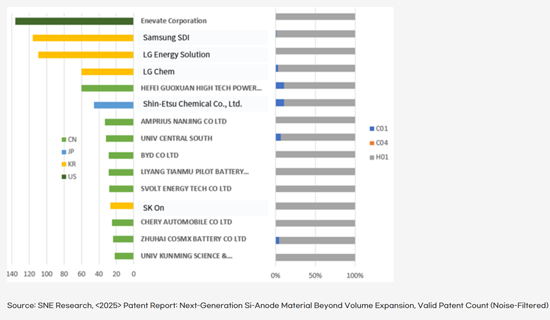 |
市場調查報告書
商品編碼
1784311
超過體積膨脹的下一代矽系負極材料:Patent Report(2025年)<2025> Patent Report: Next-Generation Si-Anode Material Beyond Volume Expansion |
||||||
由於高能量密度電池需求的快速成長,矽基負極材料的全球技術趨勢和市場前景已成為研發的重點。特別是,針對SiO-SiC複合負極技術的專利分析清晰地表明,矽基負極材料具有巨大的潛力,能夠克服石墨基材料的局限性,並支持下一代儲能系統的發展。
矽基負極技術的興起主要源於對高能量密度電池的快速增長的需求,旨在延長電動車的續航里程。電動車市場的快速成長導致人們越來越需要提高單節電池的單次充電續航里程。因此,提高電池容量已成為核心競爭因素,而理論容量幾乎是石墨10倍的矽基負極材料已成為領先選擇。
在過程中,材料的結構演變也取得了顯著進展。雖然二氧化矽基複合材料最初是主流,但近年來,碳化矽基複合材料憑藉其優異的導電性和結構穩定性備受關注。順應這一趨勢,研究正積極從傳統的 "核殼" 結構(即包覆或鍵合矽)轉向能夠有效吸收矽膨脹的 "蛋黃-殼" 結構。
此外,隨著中國率先加強材料國產化策略,韓國和日本企業也積極準備自主生產和採購矽基負極材料。
最後,對矽基負極材料的專利分析和技術發展趨勢進行深入研究後發現,專利申請的主要領域大致可分為複合材料結構設計和批量生產過程。在複合結構設計領域,SiC-SiO2、Si/C 和 Si@C 結構體係以及多孔結構的開發是關鍵主題。韓國 LG Energy Solution 和三星 SDI 等公司正積極申請複合結構設計和介面穩定技術的專利,以拓展實現高能量密度電池的方法。日本信越化學工業株式會社 (Shin-Etsu) 則利用其在矽基材料合成和表面改質(Si/C 塗層)方面的專長,致力於提高矽基負極材料的品質和良率。

本報告調查並分析了全球矽基負極材料市場,提供了專利申請的最新情況、各公司的技術戰略、美國、中國、韓國和日本等主要國家的專利趨勢以及最新的研發趨勢。
目錄
第1章 簡介
- 分析的背景和目的
- 矽系負極材料概要
- 矽系負極材料結構
- Si/SiO/SiC
- 矽系負極材料的缺點
- 矽系負極材料的發電的歷史
- 對矽系負極材料的缺點的解決的辦法
- 專利的範圍和調查方法
第2章 專利申請趨勢的簡介
- 原始資料/有效專利選擇
- 專利申請趨勢:依年份
- 申請人趨勢:依國家
- 技術發展階段
- 國內主要應用趨勢
- 主要申請人的應用趨勢
第3章 主要專利的調查
- 重點專利清單及技術分類
- 主要專利趨勢分析
- 已轉讓及爭議專利簡介
第4章 結論·附錄
- 主要專利
- Sila
- GROUP14
- Shenzhen
- Resonac
- ENEVATE
- Stanford
- Large Kettle
- Shin-Etsu
- BTR
- LG Chemical Co., Ltd.
- SDI
- 結論與暗示
- 附錄1. 主要專利點的清單
The global technology trends and market outlook for silicon-based anode materials are emerging as a critical R&D focus, driven by the rapidly growing demand for high-energy-density batteries. In particular, patent analysis centered on SiO-SiC composite anode technologies highlights the increasing potential of silicon-based anode materials to overcome the limitations of graphite-based materials and support the development of next-generation energy storage systems.
The need for patent analysis on silicon-based anode materials can largely be explained in three aspects.
First, the protection of intellectual property rights and the securing of technological leadership serve as important drivers. Considering the unique nature of silicon-based anodes-having higher theoretical capacity than conventional graphite while needing to address the issue of expansion during repeated charge-discharge cycles-companies must file more detailed patents to understand the technological directions of competitors and protect their own innovations. In particular, the rapid increase in patent applications related to silicon-based composite anodes in countries such as the U.S., China, and Korea heightens the possibility of companies becoming involved in intellectual property disputes.
Second, companies need to analyze essential patents in order to identify potential patent disputes or issues in advance.
Lastly, the expiration of key patents and how to effectively utilize the resulting gaps remain critical challenges. If SiO-based patents dominate major markets, companies will need to develop SiC-based composite structures or new surface coating technologies.
The background behind the rise of silicon anode technology can first be attributed to the rapid increase in demand for high-energy-density batteries aimed at extending electric vehicle driving range. As the EV market has grown rapidly, the need for longer driving distances per charge at the cell level has intensified. Accordingly, improving battery capacity has become a core competitive factor, and silicon-based anode materials-with a theoretical capacity nearly 10 times that of graphite-have emerged as a strong alternative.
In this process, structural evolution of the materials has also progressed noticeably. While SiO-based composites were initially mainstream in the industry, SiC-based composites, with advantages in electrical conductivity and structural stability, have recently gained prominence. Reflecting this trend, research has been actively shifting from conventional "core-shell" approaches that coat or combine silicon, toward "yolk-shell" structures that can effectively absorb silicon expansion.
In addition, as China takes the lead in strengthening material localization strategies, Korean and Japanese companies are also beginning preparations to produce and procure silicon anode materials independently.
Lastly, a closer look at the patent analysis and technological development trends of silicon anode materials reveals that the core patent application areas can largely be divided into composite structure design and mass production processes. In the area of composite structure design, key themes include SiC-SiO, Si/C, and Si@C structural systems, as well as the development of porous architectures. Korean companies such as LG Energy Solution and Samsung SDI are actively filing patents related to composite structure design and interfacial stabilization technologies, thereby expanding methodologies for implementing high-energy-density batteries. Japan's Shin-Etsu, leveraging its expertise in Si-based material synthesis and surface modification (Si/C coating), is focusing on improving the quality and yield of silicon-based anode materials.
Ultimately, patent analysis of silicon-based anode materials goes beyond merely assessing the current state of technology-it serves as a foundational effort that will shape the core competitiveness of the secondary battery industry in the future. Through this, companies can not only systematically protect their own technologies, but also establish a platform for leading continuous innovation in a rapidly evolving market.

Strong Points of This Report:
- 1. Provides a multifaceted analysis of the current status of patent applications and competitor technology strategies for silicon-based anode materials as alternatives to graphite.
- 2. Compares and summarizes patent trends by major countries, including the United States, China, South Korea, and Japan.
- 3. Outlines the latest R&D trends shifting from SiO-based composites to SiC composites and yolk-shell structures, allowing readers to grasp changes in market trends at a glance.
- 4. Includes patent comparisons by company (e.g., BTR, BYD, LG Energy Solution, Samsung SDI, Shin-Etsu).
- 5. Covers a wide range of silicon-based anode technologies applicable to the entire battery industry-including EV batteries and ESS-making it broadly useful for material companies, battery manufacturers, and related research institutions.
Table of Contents
1. Introduction
- 1.1. Analysis Background and Purpose
- 1.2. Overview of Silicon Anode Materials
- 1.2.1. Structures of Silicon Anode Materials
- 1.2.2. Si/SiO/SiC
- 1.2.3. Disadvantages of Silicon Anode Materials
- 1.3. Power generation history of Silicon Anode. materials
- 1.3.1. Solution to the Shortcomings of Silicon Anode Materials
- 1.4. Patent Scope and Investigation Method
2. Introduction to Patent Application Trends
- 2.1. Raw Data / Valid Patent Selection
- 2.2. Trends in patent applications by year
- 2.3. Trends of Applicants by Country
- 2.4. Technology growth stage
- 2.5. Major National Applications Trends
- 2.6. Key applicant application trends
3. Investigation of key patents
- 3.1. Key patent list and technology classification
- 3.2. Identifying Key Patent Trends
- 3.3. Transfer, Introduction of Dispute Patents
4. Conclusion & Appendix
- 4.1. Key Patents
- 4.1.1. Sila
- 4.1.2. GROUP14
- 4.1.3. Shenzhen
- 4.1.4. Resonac
- 4.1.5. ENEVATE
- 4.1.6. Stanford
- 4.1.7. Large Kettle
- 4.1.8. Shin-Etsu
- 4.1.9. BTR
- 4.1.10. LG Chemical Co., Ltd.
- 4.1.11. SDI
- 4.2. Conclusions and Implications
- 4.3. Appendix 1. List of Key Patent Points











